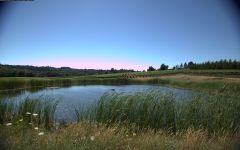Schramsberg Reserve Brut 2003
-
Wine
Spectator -
Wine
Enthusiast -
Connoisseurs'
Guide


Product Details
Your Rating
Somm Note
Winemaker Notes
The Reserve is well-suited with a main course, such as fruit-stuffed veal and pork tenderloin, roasted duck with mango, cedarplank grilled salmon and curried chicken salad. This flavorful bubbly also can be served as an apéritif with smoked oysters, caviar and such hard cheeses as aged Swiss Sbrinz, Sonoma Vella Jack or Irish Coolea.
Professional Ratings
-
Wine Spectator
Rich and full-bodied, with aromas of baked apple, ginger and brioche and layered flavors of cinnamon, delicate cherry and vanilla spice that end on a crisp, vibrant note.
-
Wine Enthusiast
The blend is 75% Pinot Noir with the balance Chardonnay, and the grapes come from fourcounties, led by Mendocino. The wine is rich and full-bodied in strawberry, raspberry, citrus, roasted almond, toasted coconut, brioche and vanilla flavors that are a little sweet. The bubbles are somewhat harsher than you might expect, but this brut could be going through a phase.
-
Connoisseurs' Guide
There are challenging aspects to this wine, and they both enhance its personality and ask if things have gone too far. Those who take delight in a broadly toasty, nervy style are going to find things to like here much in the same way that some of the most characterful Champagnes challenge the notion of austerity as a demanded virtue. No one will miss its rich "biscuits to spare" depth, but be forewarned, this generous wine is not for everyone.
Other Vintages
2012-
Wine
Enthusiast -
Wilfred
Wong -
The Somm
Journal -
Wine
Spectator -
Connoisseurs'
Guide
-
Wine
Enthusiast -
Connoisseurs'
Guide
-
Wine
Enthusiast -
Robert
Parker -
Wine
Spectator -
James
Suckling
-
Wine
Enthusiast -
Wine
Spectator
-
Wilfred
Wong -
Wine
Enthusiast -
Robert
Parker -
Wine
Spectator
-
Wine
Enthusiast -
Robert
Parker -
Wine
Spectator -
Connoisseurs'
Guide
-
Wine
Enthusiast -
Wine
Spectator -
Wine &
Spirits
-
Wine
Enthusiast -
Robert
Parker -
Connoisseurs'
Guide -
Wine
Spectator
-
Wine
Enthusiast -
Wine
Spectator -
Connoisseurs'
Guide
-
Wine
Enthusiast
-
Wine
Spectator








In 1965, Jack and Jamie Davies founded Schramsberg and set out to make world-class sparkling wine in the true méthode traditionelle style on the property originally established in 1862 by German immigrant Jacob Schram. There were only 22 bonded wineries in Napa Valley and fewer than 100 acres of California vineyards planted to Chardonnay and Pinot Noir. Schramsberg was the first California winery to provide a Blanc de Blancs in 1965 followed by a Blanc de Noirs in 1967. Now their son, Hugh Davies, leads the winery’s management and winemaking team.
The Schramsberg estate in Napa Valley’s famed Diamond Mountain District is a registered historic landmark with Napa’s first caves, hand-dug in the 1880s, and its first hillside vineyards. Quality focus drives all aspects of wine production starting with access to over 120 cool-climate sites in Carneros, Marin, Mendocino and Sonoma, which result in over 200 separate lots. Unique among California sparkling wine houses, Schramsberg ferments about 25 percent of its juice in oak barrels to produce rich, flavorful, complex wines.
Most of Schramsberg’s viticultural and winemaking practices are carried out by hand: grapes are hand harvested, the wines are handcrafted, and the bottles are stacked and riddled in underground caves. The family and the winery embody excellence and innovation in winemaking, as well as preservation of their land, their history and their community.

Representing the topmost expression of a Champagne house, a vintage Champagne is one made from the produce of a single, superior harvest year. Vintage Champagnes account for a mere 5% of total Champagne production and are produced about three times in a decade. Champagne is typically made as a blend of multiple years in order to preserve the house style; these will have non-vintage, or simply, NV on the label. The term, "vintage," as it applies to all wine, simply means a single harvest year.

One of the world's most highly regarded regions for wine production as well as tourism, the Napa Valley was responsible for bringing worldwide recognition to California winemaking. In the 1960s, a few key wine families settled the area and hedged their bets on the valley's world-class winemaking potential—and they were right.
The Napa wine industry really took off in the 1980s, when producers scooped up vineyard lands and planted vines throughout the county. A number of wineries emerged, and today Napa is home to hundreds of producers ranging from boutique to corporate. Cabernet Sauvignon is definitely the grape of choice here, with many winemakers also focusing on Bordeaux blends. White wines from Napa Valley are usually Chardonnay and Sauvignon Blanc.
Within the Napa Valley lie many smaller sub-AVAs that claim specific wine characteristics based on situation, slope and soil. Farthest south and coolest from the influence of the San Pablo Bay is Carneros, followed by Coombsville to its northeast and then Yountville, Oakville and Rutherford. Above those are the warm St. Helena and the valley's newest and hottest AVA, Calistoga. These areas follow the valley floor and are known generally for creating rich, dense, complex and smooth red wines with good aging potential. The mountain sub appellations, nestled on the slopes overlooking the valley AVAs, include Stags Leap District, Atlas Peak, Chiles Valley (farther east), Howell Mountain, Mt. Veeder, Spring Mountain District and Diamond Mountain District. Napa Valley wines from the mountain regions are often more structured and firm, benefiting from a lot of time in the bottle to evolve and soften.
